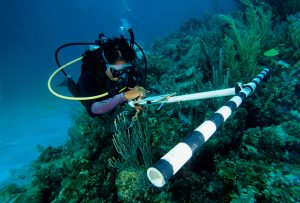On 7 October 2020, Mélina Soto hunkered down in the Mexican port town of Puerto Morelos as Hurricane Delta struck the coast she calls home at 110 miles per hour. “The sound of the wind is like a screaming, up high in the sky,” she says. “You hope for the best, but you prepare for the worst.”
Soto is the Mexico national coordinator for conservation initiative Healthy Reefs, so her mind was primarily on Puerto Morelos’ coral reef. Rich with towering elkhorn and violet fan corals, turtles and rays, this ecosystem is part of the Mesoamerican Barrier Reef: 1,000km of coral that curls along the coasts of Mexico, Belize, Guatemala, and Honduras. “Puerto Morelos is a small town. But we all depend on the reef” says Soto. Many residents are fishers, employed in marine tourism, or academics at the town’s coral research campus.
Once the storm had passed and work begun to patch up Puerto Morelos, Soto led a brigade of volunteer divers that took these efforts out to the corals, too. Bit by bit, they pieced together the storm-shattered reef. “It was like a triage” says Soto. Divers set about fixing 1,200 chunks of broken coral onto the reef with cement and ferried another 9,000 pieces to shore to be regrown in nurseries.
What made this possible was a flash of financial innovation. In 2019, Puerto Morelos’s home state of Quintana Roo purchased insurance to cover the reef, triggering emergency funding to repair it after a storm. It was a world-first. Now, similar insurance schemes are spreading to the Pacific, the Caribbean and the United States.
Increasingly, insurance is being considered a tool for securing natural capital against climate change. But as a wave of bleaching in 2023 affects global reefs, can this novel approach really protect corals against ever-warming seas?
Insurance products for a changing world
Worldwide, coral reefs provide ecosystem services to the value of $2.7 trillion annually. This includes livelihoods and food for one billion people, and flood defences valued at $1.8 billion, because reefs are natural breakwaters that can absorb 97% of wave energy before it hits the shore. Hurricanes threaten this role because they break reefs apart, coat them in sand and debris, and turn the water into a cloudy soup. These conditions block the sunlight that corals’ symbiotic algae need to photosynthesise and supply them with food.
Reefs have evolved to cope with hurricanes, but frequent battering gives corals less time to recover. “With climate change, there are more hurricanes, [they’re] more continuous and stronger,” says Maria del Carmen García-Rivas, director of the Puerto Morelos Reef National Park, a marine protected area that encompasses the reef. Pollution and warming seas heap further pressure on these embattled ecosystems.
Like with medical insurance, you need the hospital and the ambulance in order for it to workFernando Secaira
The idea that insurance could alleviate this strain first took hold in Quintana Roo in 2015, says Mike Beck. Back then, he helped pioneer this idea as the lead marine scientist for The Nature Conservancy (TNC). “All of it was completely novel” says Beck, who is now director of the Center on Coastal Climate Resilience at the University of California Santa Cruz. “On the conservation side, it was [a case of] look, at this point, we need any kind of help we can get with reefs.”
Beck and his TNC colleague Fernando Secaira began exploring parametric insurance: unlike traditional indemnity insurance, which necessitate loss assessments that delay claims, parametric insurance provides pre-agreed payouts that are immediately triggered by an agreed parameter, such as a specific wind speed. This rapid payment is a boon for hurricane-damaged reefs that can only survive a few days without help.
In 2016, TNC began work to determine what damage to expect from different wind speeds, which helped them estimate the associated restoration costs. But they also needed the capacity to patch up the reefs: “Like with medical insurance, you need the hospital and the ambulance in order for it to work,” explains Secaira, who leads TNC’s climate risk and resilience efforts in Mexico. So, working with Mexico’s national park service and local researchers, TNC launched restoration training for volunteer divers in Quintana Roo. By 2018, this emergency ‘Guardians of the Reef’ brigade was ready to dive to the corals’ rescue.
Meanwhile, the cash for the insurance premium was raised by government and private-sector funding. The latter was collected via a tax on the beachside hotels that depend on the tourism that the reef underpins. In 2019, the state purchased a policy from insurance company Seguros Banorte and reinsurer Swiss Re. The policy covers 400km of coral, triggered by winds of 96 knots within 60km of the reef. In 2020, the first payout for almost $800,000 was made.
Beyond Quintana Roo
Increasingly frequent hurricanes make these costs unsustainable for states to pay. Transferring this risk to insurance companies is therefore an attractive option, while insurers benefit from the relatively high premiums.
However, these premiums can be reduced, explains Simon Young, the Climate and Resilience Hub’s senior director at insurance broker Willis Towers Watson (WTW). “If you’re looking at the probability of a certain wind speed, then the error bar on that is more limited,” he explains. “So, you can hold [insurers] much more to a price that reflects the risk than you can with more uncertainty.” The positive publicity linked to ecosystem insurance also gives insurance brokers leverage to negotiate favourable premiums, he adds.
Building on this success, a regional conservation funding institution called the MAR Fund purchased parametric insurance from AXA Climate in 2021, covering four Mesoamerican Reef locations in Mexico and Belize. Developed at the same time as the Quintana Roo scheme, the policy relies on a precise metric that categorises wind speed and reef proximity into distinct bands, each corresponding to a percentage of the payout. The insurance aggregates several reef sites under one policy, which has also helped secure favourable premiums, according to Claudia Ruiz, MAR Fund’s reef rescue initiative coordinator.
In 2022, the fund received its first payout of $175,000 to repair hurricane damage to Belizean reefs, following Hurricane Lisa. This year, the policy was renewed for the third time and expanded to cover 11 locations, now incorporating Guatemala and Honduras. “This is a very innovative programme,” Ruiz says. “It is working.”
A parametric insurance project for Hawaii was developed in 2022, while similar initiatives are being considered for the Pacific Islands and Indonesia.
These tools are also evolving to serve other ecosystems, like hurricane-hit mangroves in Mexico. WTW is currently exploring how tailored insurance products could “help support the mangroves themselves, but also the blue carbon that they are sequestering,” says Sarah Conway, director and head of WTW’s Ecosystem Resilience Practice.
Growing complexities
The nascent field has had some teething pains. For example, the 2020 payout to the state of Quintana Roo was held in a government gridlock for months before being released; TNC and others supplied interim cash to allow the time-sensitive restoration work to go ahead.
Meanwhile, the MAR Fund is trying to secure more sustainable funding streams for premiums: so far it has relied on grants from the UN Development Programme and others. “This programme cannot rely only on international cooperation funding” says Ruiz. Chip Cunliffe, the programme and risk director for the multi-sector finance initiative Ocean Risk and Resilience Action Alliance (ORRAA), is familiar with this problem: “Who is going to pay the premium? I think that’s always one of the big questions.”
However, these challenges are eclipsed by something much larger. This year, warming oceans have brought widespread reef bleaching, when heat-stressed corals eject their vibrantly hued, symbiotic algae. Caribbean reefs haven’t been spared. Speaking at the end of a day diving on the Puerto Morelos reef, García-Rivas, director of the marine protected area, described an ecosystem sapped of colour: “The bleaching is terrible, there are a lot of dead corals. This is critical – I think it’s an emergency.”
Can coral insurance evolve to respond to bleaching? It’s a complicated picture. Compared to the clearer cause-and-effect of hurricanes, where damage can be predicted by wind speed and proximity to the reef, Soto says the parameters of a bleaching event and ocean acidification are more difficult to define. They vary widely in scale and impacts even across individual reefs, depending on species composition and general health. Warming may also bring added threats like acidification and disease. These factors increase the risk for insurance companies, which would likely be reflected in higher premiums.
The uncertainty of ocean heatwaves and bleaching also creates a conundrum for potential policyholders: what to spend the payout money on? Reefs smashed by waves can be pieced together and regrown. But bleached corals, while not necessarily dead yet, have lost a critical life partner in the algae, which may or may not return. Restoring this delicate relationship requires a set of complicated and ultimately uncontrollable conditions in the wild.
Incentives for risk reduction
There are some voices in the nascent parametric insurance field who think instruments could in fact be designed to help bleaching reefs – under specific circumstances. In 2022, AXA Climate developed a bleaching insurance product for a hotel in the Maldives that is propagating sapling corals offshore. AXA Climate’s nature initiatives lead, Ariane Kaploun, elaborates: “Here, what was interesting is that the insurable value was the money that they had engaged to plant these new baby corals into the nurseries.” The clearly defined nature of this coral project made it possible to cost the damage of potential bleaching, and with funding, fix it directly.
Ultimately, the hotel chose not to buy AXA’s policy, but Kaploun thinks it could become a blueprint for designing future insurance products. Furthermore, García-Rivas says insurance payouts could help fund research to identify the resilient corals that remain after a bleaching event and propagate those to genetically buffer reefs against climate change.
“We are still in the early days of understanding how all the pieces fit together, such that we could construct a product that there is an actual buyer of,” says WTW’s Conway. “But it’s an exciting area where there is, we think, a role for parametric insurance to play.”
The ultimate defence against acidifying oceans and bleaching reefs is to reduce global carbon emissions. In the meantime, at the ORRAA, Cunliffe believes parametric insurance is growing: “We’re now working with probably over 60 projects, and the majority of them have a finance or insurance link to them.”
Beck is hopeful that investments in reef conservation will be increasingly guided by estimates that reflect the full value that coastal ecosystems provide for fisheries and tourism, and as sea and climate defences. This could help build the case for protecting and restoring reefs preemptively before disasters hit. Beck suggests that insurance products could even be designed to offer premiums to policyholders who take this proactive approach: “When this really takes hold is when we’re offering different kinds of insurance-related incentives for the risk-reduction value of these [ecosystems].”
Back in Quintana Roo, it’s hurricane season. The dual threat of extreme weather and marine heatwaves has left reef rescuers like Mélina Soto desperate for solutions. “The bleaching is so intense that we will need more action,” she says. “We know that some of the corals that have been restored are bleached right now. That doesn’t mean they are dead: that’s why we are hoping for the best, that they might survive.”











